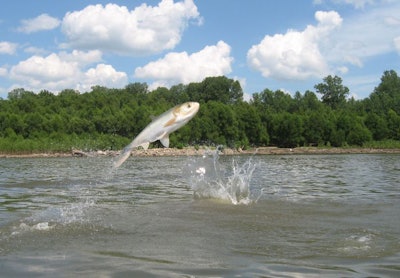
Asian carp literally jump into headlines occasionally after one of the fish leaps from the water and slaps a boater, like a Monty Python sketch escaped into the wild. The real problem with Asian carp comes from the competition they present to native freshwater fish and the negative effects that has on fisheries. However, the fish are eaten regularly in their home ranges, and various efforts in the United States have found ways to put the fish on people’s plates. Several pet food and treat companies now use Asian carp in formulations. This helps conservation efforts by creating an economic incentive for harvesting the Asian carp.
While those fish technically originated in Asia, there is no such species as an Asian carp. Instead, Asian carp refers to several different fish: bighead carp (Hypophthalmichthys nobilis), black carp (Mylopharyngodon piceus) grass carp (Ctenopharyngodon Idella) and silver carp (H. molitrix). Only silver and bighead regularly jump, but all of them are problems for the environment, but in somewhat different ways. In Fisheries Magazine, conservation professionals pointed out that lumping all these fish into one term causes problems. It fails to acknowledge cultural and ecological differences among the fish, as well as confounding communications both to the public and when exporting to China, or otherwise translating the fish’s name to Chinese.
A few pet food companies have avoided the confusion by focusing on silver carp in their dog food. For example, Annamaet Re-Juvenate Senior Formula uses silver carp specifically. On World Oceans Day, June 8, Chippin launched Silver Carp Daily Food, branching out from previous product made with cricket and spirulina.
“We are committed to science-backed nutrition and did a deep dive on the nutrition quality of silver carp,” Haley Russell, co-founder and CEO of Chippin told Petfood Industry in an email. “By sourcing directly one species of fish, we could build more consistency in our product and ensure we could take a research-driven approach to crafting our food.
“We do think that the group of fish collectively called 'Asian carp' should be renamed. We know Chilean sea bass grew in popularity after a name change, and we would be enthusiastic to see how that could help support a broader market of these fish for pets and people domestically.”
Along with environmental benefits, silver carp provide a complete and highly digestible protein, that includes all 10 essential amino acids for dogs, along with omega-3 fatty acids, she said. For dogs with allergies or sensitive digestion, silver carp can be an alternative protein.
Asian carp as novel pet food ingredient
Asian carp species eat plankton needed by other fish, procreate prolifically and endanger boaters by leaping from the water. After escaping and being released into American waterways in the 1960s and '70s, Asian carp have reduced the profitability of many freshwater fisheries in the US Midwest and South. Now these unholy mackerel threaten the billion-dollar fishery of the Great Lakes. Expensive barriers and eradication programs have not solved the problem.
Back home in China, chefs prize the fish, yet Asian carp meat is largely unused in the US. Meanwhile, this wasted resource lays waste to aquatic ecosystems. The most common Asian carp species, silver and bighead, eat by filtering tiny plants and animals from the water, as whales do. Since they eat low on the food chain, toxins don’t build up in their meat, or bioaccumulate, as much as in predatory fish. Along with food safety and nutrition, Asian carp can address other health issues.
Animal health and native ecosystems benefit from the use of Asian carp in pet treats; at the same time it helps struggling American fishermen make a living. Federal regulations prevent fishermen from throwing the invasive carp back into rivers, although nets bring in tons of the fish inadvertently. Those mountains of fish are worth little cash at processors, if the facility will buy them at all.














